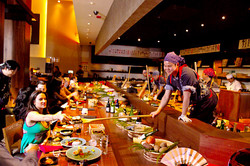Inakaya
231 W. 40th St., between Eighth & Broadway.
(212) 354-2130
Dinner, Mon.-Sun., 5 p.m.-11 p.m.; lunch, Mon.-Fri., 11:30 a.m.-2 p.m.
CUISINE: Traditional Japanese robatayaki.
VIBE: Dinner theater.
DON’T-MISS DISH: Chicken thigh skewers, Kaku Ni simmered Berkshire pork belly, Kinki deep-sea snapper, ginkgo nuts.
AVERAGE PRICES: Appetizers, $10; entrees, $20; desserts, $5.
RESERVATIONS: Recommended for the robata counter.
About four years ago, I ate at Inakaya in Tokyo. The locals said I shouldn’t miss it.
They warned me it’s touristy. Guess what? It is. And the food’s excellent.
Now New York‘s
got its own Inakaya, and the food is just as good. This one’s scaled
to New York, so it’s triple the size of the Tokyo flagship, and so is
the menu.
It’s right across from the Port Authority at the edge of Times Square, in the Olive Garden–Red Lobster–Applebee’s district.
From the sidewalk, Inakaya looks like just another tourist trap —
people clustered together, snapping photos. Inside, you see what
they’re so excited about. They’re watching the mochitsuki, a
mochi-pounding ceremony that celebrates the Japanese New Year.
Every night is New Year’s at Inakaya. And that means every diner
gets to slam a giant mallet into a giant pestle, turning steamed rice
into sticky sweet rice cakes.
Mochi this good makes other mochi seem like edible playdough. In a
way, what you’re seeing through the window is Tokyo, and it’s no wonder
most of the clientele is Japanese.
The only thing that’s different is all the tourists snapping photos.
But if you’re looking for peace and quiet, eat somewhere else.
There’s a lot of shouting and clapping at Inakaya. Order a beer or
a sake or even a glass of water, and the entire staff shouts your order.
Inakaya’s not your average restaurant. In fact, it’s the first
genuine robatayaki — a farmhouse-style grill — in New York. So reserve
a spot at the 30-seat robata counter, where the real ceremony between
you and the grill chef takes place.
Order a Sapporo
and your kimono-clad chef serves it to you with a long wooden paddle.
Order the chicken thighs and the chef will ask whether you prefer them
with salt or tare sauce.
The best items on the menu come from Japan.
The kinki, a deep-sea snapper, is shipped from Tsukiji Market, but
that’s not why it’s wonderful. What makes it wonderful is that it’s
crusted in Japanese salt and served whole — fins and all.
Fish this fresh and flavorful isn’t cheap. It’s $45, but worth it, and so is the $45 Japanese Wagyu.
The menu looks more like a list of ingredients than dishes — 16
vegetables, three kinds of seafood, dried fish and meat. This is simple
food, which means you can truly taste the subtleties of each
ingredient.Most think ginkgo nuts are some exotic, foul-smelling
variety, but they’re not. They’re actually a fruit that falls from
ginkgo trees all over the city.
Order the skewered ginkgo nuts brightened by lemon and you’ll discover their rich nuttiness and soft flesh.
You can order four types of mushrooms from the robata and do your own side-by-side comparison.
Hot dishes from the kitchen worthy of attention are the Kaku Ni (Berkshire pork belly in a sweet soy broth) and the Chawan Mushi.
The Chawan Mushi — a teacup of steamed egg custard layered with
chicken, scallions and shrimp — is one of the most complicated items on
the menu.
The lowest points of the menu were flavorless tsukune (chicken
meatballs) and both the tuna and ika natto (marinated squid with
fermented soybeans).
Inakaya is fine for pre-theater dining, or you might just skip the theater and go to Inakaya for a great food show.










Heya i am just to the key moment the following. I discovered this plank we in discovering It genuinely handy & them helped me to available much. I’m hoping to deliver something once again in addition to support others just like you assisted me personally.